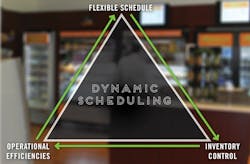How To Get The Most From Dynamic Scheduling Of Micro Markets
Micro markets need regular upkeep. Between constant checking of fresh food dates and facing shelves and racks, micro markets always look better after a service visit. How then can an operator benefit from dynamic scheduling, a process that in vending leads to fewer driver visits instead of more? Here are the tricks, and other advantages, to using dynamic scheduling in micro markets.
Dynamically service part of a market
There are different areas of a micro market with different service needs. Some operators are using this to their advantage. They have a route driver dedicated to fresh food who checks dates and straightens up the food cooler at each micro market and/or food vending machine. However, because beverages and snacks don't require as much service, these sections could be serviced differently. Drives focused on beverages and snacks can work based on need, or dynamically scheduled to create efficient routes and even more time to freshen up a market.
Deal with winter or inclement weather
Most winters include some weather that causes employees to work from home rather than come to the office. This affects sales, dropping revenues double digits in some cases. However, having real-time reporting on what is in the micro market and what needs restocking, can be a real asset when dealing with bad weather. Operators able to plan ahead can include items with a longer shelf life in their micro markets when a storm or extreme cold is expected. Reporting features then make it possible to dynamically schedule during these timeframes.
Adjust to telecommuters and HR needs
There are more telecommuting employees in the U.S. now than ever before, 3.9 million people or 2.9 percent of the workforce, according to the latest report. This presents difficulty for micro market operators trying to provide the right variety of food, snacks and drinks to locations. Compounding that is the needs of human resource professionals, many of whom are trying to lure and attract employees back to the office. This means better breakroom spaces with a greater need for refreshment solutions such as micro markets and workplace cafes with lots of fresh food and healthy options. If operators don't have enough food items, micro markets lose some of their attraction for employees who wouldn't use a vending machine. With too much food, the spoilage is too high as not enough people are in the location to purchase the items. It's a balancing act that requires proper (often varied) scheduling based on sales analysis.
Gain operational efficiencies
For operators who have implemented technology successfully into their vending operations, many of the same advantages can be carried over into micro markets. Specifically, dynamically servicing micro markets aligns service with the needs of the location rather than a static schedule. Products can be restocked before locations call for emergency service and yet route drivers won't be sent there when only a few items need restocking. It encourages operators to cross train drivers as well, since there is no guarantee who will be running to which location. This can ensure service levels remain consistent.
Compensate drivers accordingly
While efficient, dynamic scheduling can be a challenge for route drivers. Many drivers are more comfortable with a set schedule, but with patience and motivation, drivers can adapt. In commission-based compensation, the increased productivity can lead to happier drivers. If there are no commissions, then bonus programs or recognition for low spoilage and other areas within the driver's control can be compensated. This helps drivers be more flexible and open to the unpredictable nature of a dynamic scheduling.
Dynamic scheduling has many advantages for micro markets and continues to make operators strong contenders in the convenience services field.
About the Author

Emily Refermat
Emily Refermat began covering the vending industry in 2006 and served as editor of Automatic Merchandiser from 2012 to 2019. To reach the current editor of Automatic Merchandiser and VendingMarketWatch.com, email [email protected].
